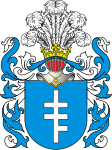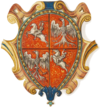|
Pilawa coat of arms
Pilawa (Polish pronunciation: [piˈlava]) is a Polish coat of arms. It was used by many noble families known as szlachta in Polish in medieval Poland and later under the Polish–Lithuanian Commonwealth, branches of the original medieval Piława Clan (Pilawici) family as well as families connected with the Clan by adoption. HistoryThe progenitor of the Pilawa Clan was supposed to have been Żyrosław z Potoka, who was fighting the Prussians, a pagan tribe and brought himself glory in the Battle of Piława, where he fought along Bolesław IV the Curly. The legend states that Żyrosław reached the pagan chief, fought him in hand-to-hand combat and killed him. The terrified enemy hordes fled the battle field. The related legend tells also that in 1166, to commemorate the victory, Bolesław IV bestowed a coat of arms upon Żyrosław, naming it for the place, where the battle took place. BlazonThe Pilawa coat of arms assumed its final form in the late 14th century. Formerly, there were two differing patterns, and the records from the years 1387, 1388 and 1389 mention that it had to be a letter "Z" with two and a half of a cross, or an arrow with two and a half of a cross. Notable bearersNotable bearers of this coat of arms have included:
Family name changes during the Second World War and 1944–1953The communist government of Poland was in deep opposition to every rich (specially noble) family. Hundreds of Potockis were killed by NKVD and Red Army. Many Potockis, who decided to stay in Poland were forced to change their family names (otherwise they could be killed, imprisoned or have other problems). The most popular changes was from Potocki to Nowak, Kowalski, Gnejowicz, Stanisławski, Pryszkiewicz, Wszelaki, Petecki, Blacha, Musiał, Woldan, Walera, Melka, Madej and Pastuch. Gallery
Paintings
See alsoExternal links
Bibliography
|
||||||||||||||||























